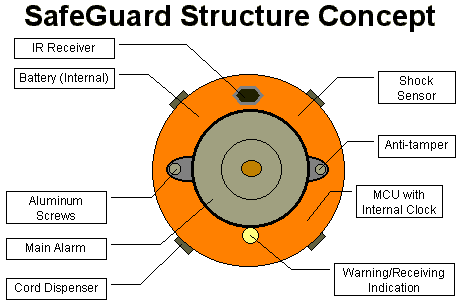SafeGuard [Under Construction] | |||
| <<< Home | Concept Diagrams | Latest Stage | Links >>> |
| Abstract | <<< Back |
 |
The "SafeGuard" Shock-sensing Alarm Project is something that was first inspired the by loss-prevention devices I witnessed during a summer retail job. This design, however puts the emphasis on continuous user interaction and remote operations. The basic concepts are still there: (1) apply sensors to detect if the unit is being tampered with and (2) provide a loud alarm to alert bystanders. |
| Concept |
Concept Like retail anti-theft devices, the SafeGuard attaches to articles such as books, backpacks, briefcases using a set of retractable cords. Though the cords can stretch to a length of 36 inches, the SafeGuard may also be simply hidden in or under whatever needs protection. Like any home alarm system, the SafeGuard will have multiple levels of protection. There is an initial Micro-power state is the initial start-up state, and thanks the low-power components and internally-clocked AVR microcontroller, the SafeGuard can theoretically idle in this state for years before the battery is depleted. Additionally, there are effectively four arm states that decide the loudness and persistence of the alarm. Transitioning between states is done using an infrared controller. Thanks to recently-donated components, there are also a number of defenses integrated into the SafeGuard itself. Firstly, a web of continuity sensors will trigger the device if the casing is opened or major components fail. Software filtering will help eliminate false alarms and the controller will use a lockout feature that can repel any attempt to read or hack the control software. |
| Latest Stage |
Development ProgressProgress has been somewhat mixed to this point. Because of the relatively small-size, requirement for a low-power parts, and smaller microcontroller--many aspects of the project have to be optimized and redesigned to make the project "come together." Also, my first prototype used a unknown transistor model that appearently had a very low gain characteristic and caused the alarm to be unacceptably quite. The upcoming revision will most likely use a new transistor type altogether. Even with the setbacks, other aspects are going very well. For the battery's small size, the alarm is surprisingly loud. The remote control feature also works better than expected, and can sometimes receive signals from the next room. Overall, the project is very close to completion. Check it around February 2006. |